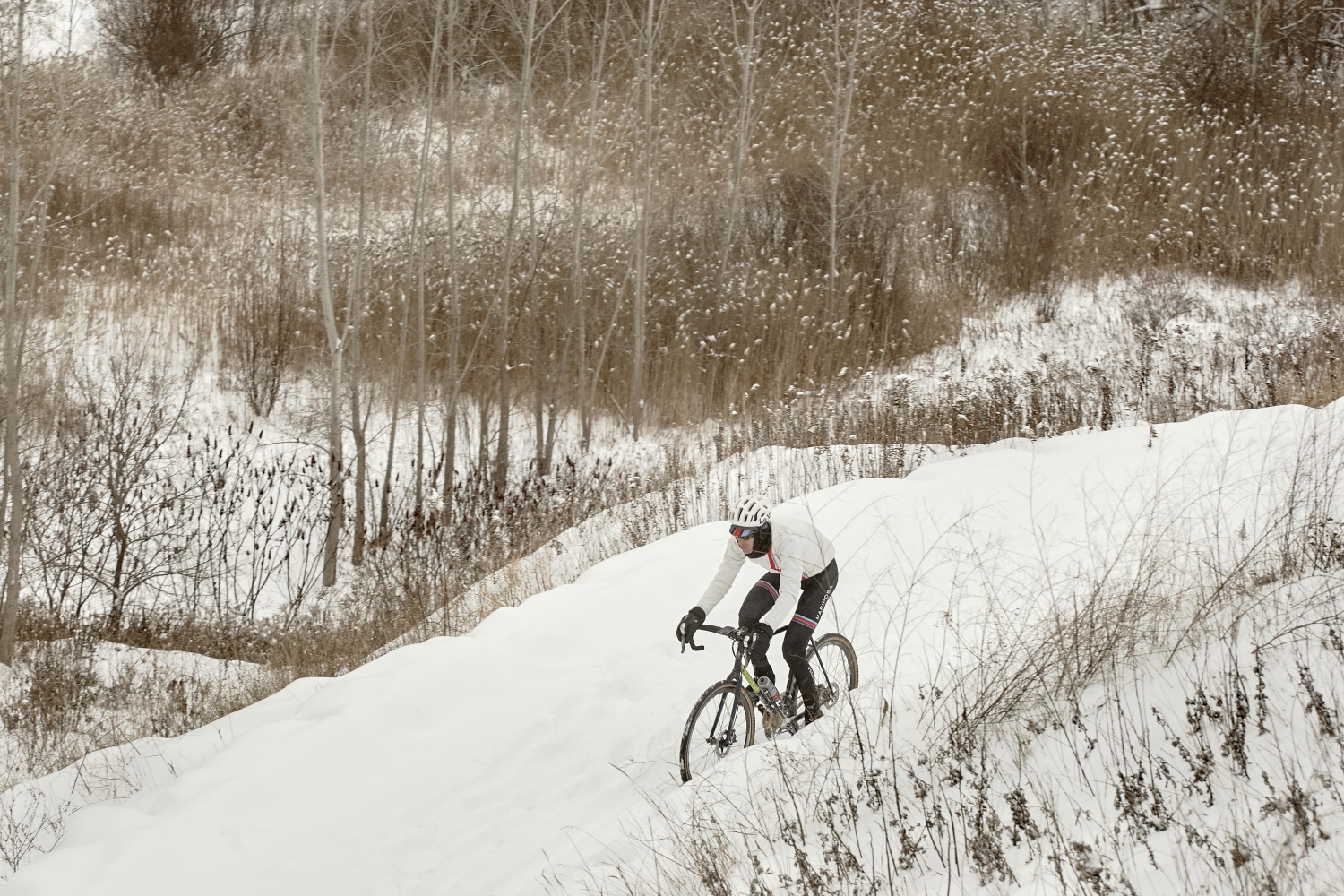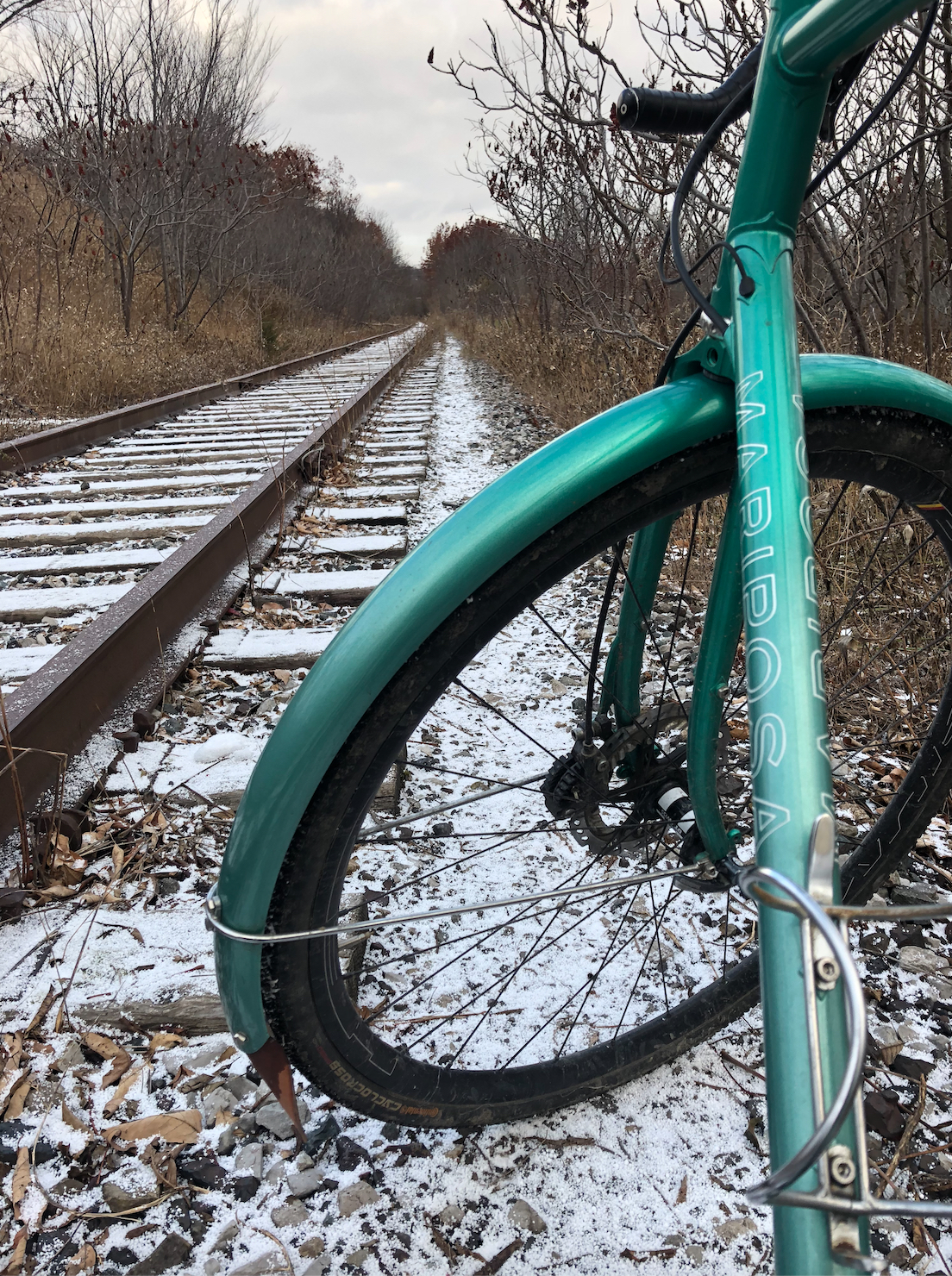Winter riding can be an enjoyable adventure and a whole lot better than riding the trainer if you are well prepared for the conditions. Unprepared, it can be a miserable ordeal.
While wearing proper clothing and riding a bike fitted with fenders, there are few weather conditions that make a ride unpleasant. Fenders keep water from soaking your backside, and they prevent road grit from chafing skin. The plumes of water that spray from the wheels are eliminated by the fenders which keeps your backside and feet dry. On a group ride, everybody is more comfortable without a constant wheel-spray of dirty water showering their face. With the spray from the wheels eliminated, a cyclist with a good rain jacket, or rain cape, can stay mostly dry for the duration of any ride.
There are few, if any, reasons not to train without them during inclement weather. Fausto Coppi rode with them. Phil Anderson used them. Many current pros fit them to their bikes during the off-season, especially those who live northern climates .
When I raced professionally with Team Sky, they always gave the riders who live in northern cold climates cyclocross bikes that were set up in our road positions and were drilled and tapped by the mechanics so that the fenders could be cleanly mounted. Edvald Boasson Hagen rode his on days where the deep Norwegian snow, or ice cold rain, would otherwise keep him indoors.
If I were to have one bike, it would be a bike with fenders. Keeping you dryer and warmer, they allow you to ride comfortably for hours. After all, riding with a wet chamois and cold feet doesn’t toughen up a rider; it simply makes him/her miserable. By contrast, being able to ride regardless of the weather, makes any cyclist stronger.
In Toronto, I’m surprised by how few cyclists use fenders, especially considering the weather. Commuters buzz around town on their fixies, hybrids, and ‘cross bikes with streaks of dirty mud up their backsides. With fenders, they could show up at work fairly dry and clean. It is puzzling that so many cyclists are resistant to mounting them on a bike that they’ll ride through the winter. Too often, fashion and style dictate how most want to look while out on the road–not comfort and function. Or, perhaps, it is simply because they don’t realize just how much protection fenders can give from the wet.
For the winter, it is ideal to install fenders on an All-Road, Cyclocross or Gravel bike that has fender eyelets and sufficient clearance. Unfortunately, some bikes don’t easily accommodate fenders, but with some cutting, fiddling and a few small clamps, it can often be done.
Thirty years ago, almost all steel frames came with eyelets and had the clearance around the brakes, forks, and bottom bracket to mount fenders. Having always focused on custom bicycles building, Mariposa Bicycles has the ability to add eyelets for fenders on our bikes and the Allied ABLE carbon gravel bikes we carry accommodate fenders as well. With the current trend back towards gravel frames with clearance for larger 32 – 42 mm tires, many, mass carbon bike manufacturers are starting to add eyelets to their bicycle frames and forks as well so that fenders can easily be mounted and removed.
A few companies make decent clip-on fenders. Although they do not do as good a job as a full length set of fenders, they are better than nothing, and they’ll make any ride in the wet more pleasant.
With a good mud flap at the bottom of the front fender the rider’s feet are kept much drier. One at the bottom of the rear mudguard makes riding in a group in the wet more pleasant, as nobody will be sprayed in the face with foul road water. While training on the west coast of Canada, where the roads rarely seem to fully dry out in the winter months, the groups I rode with insisted that every rider not only have mudguards, but also mud flaps. This stops the last inches of uncovered wheel from spraying water. A rider without a flap was sent to the back for the duration of the ride, unable to ride at the front or socialize. Most riders made their own mud flaps with a water bottle cut in half or a piece of plastic cut from a detergent jug. Some were neatly cut out and zip-tied on, while others were ragged and stuck on with duct-tape. But they all did the trick.
Dressing for the cold
The right bike and proper apparel not only eliminates excuses to avoid riding in the rain, but they can even make it enjoyable. Here are a few tips that will keep you riding through the winter:
- Layer clothing so you can cool off when warm and to avoid getting chilled from sweat. Merino wool base layers do an excellent job of thermal regulation, as they keep warm, while wicking away the sweat. A thermal jacket which is water repellent is ideal for the outer layer. Keep a thin rain shell in your back pocket which can be applied if you stop for a snack or have to change a flat tire.
- Feet and hands are often the first parts of the body to feel the cold. The body’s extremities get less blood flow, as they move little when cycling and are more exposed to the wind. Toes are most affected by the cold as they are moving through the cold air faster than any other part of the body. Keeping your hands warm is never easy. If there is any moisture, waterproof shells will keep your hands dry. Often a thin shell with a merino wool liner will keep your hands protected from both moisture and cold, but in extreme cold (<0 Celsius), wear mitts with a Goretex outer shell, rather than gloves.. If your fingers are together, they will stay warmer. Glove fit is important as well, they need to cover your wrists as there should be no gap between your gloves and your jacket or jersey. Also, fingers will get cold more quickly if the gloves are too tight or short.
- A thin pair of high (above the ankle) wool socks, paired with winter specific thermal cycling shoes or shoes with no vents or vents covered (there are many ways to cover shoe vents: duck tape is cheap and works well, even plastic baggies to cover the toes can work well inside your shoe). On the outside of your shoes, thin, but wind and water resistant thermal shoe covers will keep your feet warm and dry without restricting mobility.
- Legs move constantly on the bike and do the bulk of the work, therefore a balance between warmth, breathability, wind protection and freedom of movement must be achieved in kit choice. Heavy tights over cycling shorts are bulky, restrict movement and often cause too much moisture build up in the crotch area. In above freezing conditions, fleece lined bib shorts with fleece lined leg warmers will keep you warm and provide maximum movement, as well as the option to remove leg warmers if conditions improve while on the road.
- Wear a thermal cap under your helmet that protects your ears from the wind.
- Cover your neck with a buff to protect it from windchill.
- Apply Vasoline on your face to protect it from wind chill.
- Carry Hotshots in your back pocket to warm up when your fingers and/or toes get cold. Wear hotshot shoe inserts on extremely cold days.
- Use front and rear lights, as there is less daylight in the winter months.
- Install winter tires. There are loads of good options depending on the severity of the conditions. The Schwalbe Marathon Winter Plus Tires or the Schwalbe Ice Spiker tires with ice spikes will give you good grip on sheet ice. If you prefer not to use tires with metal spikes, the Continental Winter Top Contact tires provide excellent grip as well, as they are designed with countless rubber lamellae (biting edges permanently interlock with the surface).
- Lastly, the head and neck is often where the most heat is lost. The new aero helmets are often overlooked when considering winter gear. Because aero helmets do not have vents, they provide added warmth in the cold weather. A cotton cap under your helmet will help achieve this as well. In extreme cold, it’s important to cover your ears. This can be done with a thermal cycling cap. Unlike hats without peaks, cycling caps will also keep the rain, snow and sun out of your eyes. When rain is pelting down, glasses will often fog up or become so dirty that visibility is affected. A simple cap with a peak will keep the spray from others’ wheels and the rain from the sky out of your eyes–which is why you’ll often see the professionals wearing peaked caps in early season Classics when the weather is foul. Neck gators can also be useful for keeping in the body heat and, if they are long enough, they can be stretched up over your head to provide additional warmth.
The golden rule is to never under dress. Layered clothing can always be peeled away and loaded in pockets (or a handlebar or a large saddle bag) while if you don’t have enough clothing the ride will be miserable.
Dressed for the conditions, winter riding can be a fun adventure.



Great mix of useful info and sales promotion. Kinda heavy on fender info. But understand how essential they are if riders are going to have any chance of being reasonably comfortable in the wet and cold.. Your advice is a story that many riders should have if they’re preparing for Fall, Winter or Spring conditions. Thank you1